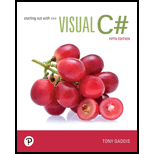
Pearson eText for Starting out with Visual C# -- Instant Access (Pearson+)
5th Edition
ISBN: 9780137502783
Author: Tony Gaddis
Publisher: PEARSON+
expand_more
expand_more
format_list_bulleted
Question
Chapter 9, Problem 4AW
Program Plan Intro
Comparing DateTime objects:
- Two DateTime objects can be compared using C# relational operators.
- It is used to determine whether one of the objects is later than, earlier than, or equal to the other object.
- The working of C# relational operators is shown below:
- The expression obj1>obj2 results true if obj1 is later than obj2.
- The expression obj1<obj2 results true if obj1 is earlier than obj2.
- The expression obj1==obj2 results true if obj1 is same as obj2.
- The expression obj1!=obj2 results true if obj1 is not the same as obj2.
- The expression obj1>=obj2 results true if obj1 is later than, or the same as, obj2.
- The expression obj1<=obj2 results true if obj1 is earlier than, or the same as obj2.
Expert Solution & Answer
Want to see the full answer?
Check out a sample textbook solution
Students have asked these similar questions
I need to define and discuss the uses of one monitoring or troubleshooting tool in Windows Server 2019. thank you
I would likr toget help with the following concepts:
- Windows Server features
- Windows Server versus Windows 10 used as a client-server network
I need to define and discuss the uses of one monitoring or troubleshooting tool in Windows Server 2019. thank you
Chapter 9 Solutions
Pearson eText for Starting out with Visual C# -- Instant Access (Pearson+)
Ch. 9.2 - Prob. 9.1CPCh. 9.2 - Prob. 9.2CPCh. 9.2 - Prob. 9.3CPCh. 9.2 - Prob. 9.4CPCh. 9.2 - Prob. 9.5CPCh. 9.2 - Prob. 9.6CPCh. 9.2 - Prob. 9.7CPCh. 9.2 - Prob. 9.8CPCh. 9.3 - Prob. 9.9CPCh. 9.3 - Prob. 9.10CP
Ch. 9.3 - Prob. 9.11CPCh. 9.3 - Prob. 9.12CPCh. 9.3 - Prob. 9.13CPCh. 9.3 - Prob. 9.14CPCh. 9.3 - Prob. 9.15CPCh. 9.3 - Prob. 9.16CPCh. 9.4 - Prob. 9.17CPCh. 9.4 - Prob. 9.18CPCh. 9.4 - Prob. 9.19CPCh. 9.5 - Prob. 9.20CPCh. 9.5 - Prob. 9.21CPCh. 9.5 - Prob. 9.22CPCh. 9.5 - Prob. 9.23CPCh. 9.5 - Prob. 9.24CPCh. 9 - Prob. 1MCCh. 9 - Prob. 2MCCh. 9 - Prob. 3MCCh. 9 - Prob. 4MCCh. 9 - Prob. 5MCCh. 9 - Prob. 6MCCh. 9 - Prob. 7MCCh. 9 - Prob. 8MCCh. 9 - Prob. 9MCCh. 9 - Prob. 10MCCh. 9 - Prob. 11MCCh. 9 - Prob. 12MCCh. 9 - Prob. 13MCCh. 9 - Prob. 14MCCh. 9 - Prob. 1TFCh. 9 - Prob. 2TFCh. 9 - Prob. 3TFCh. 9 - Prob. 4TFCh. 9 - Prob. 5TFCh. 9 - Prob. 6TFCh. 9 - Prob. 7TFCh. 9 - Prob. 8TFCh. 9 - Prob. 9TFCh. 9 - Prob. 10TFCh. 9 - Prob. 11TFCh. 9 - Prob. 12TFCh. 9 - Prob. 13TFCh. 9 - Prob. 1SACh. 9 - Prob. 2SACh. 9 - Prob. 3SACh. 9 - Prob. 4SACh. 9 - Prob. 5SACh. 9 - Prob. 6SACh. 9 - Prob. 7SACh. 9 - Prob. 1AWCh. 9 - Prob. 2AWCh. 9 - Prob. 3AWCh. 9 - Prob. 4AWCh. 9 - Prob. 5AWCh. 9 - Prob. 6AWCh. 9 - Prob. 7AWCh. 9 - Prob. 8AWCh. 9 - Prob. 9AWCh. 9 - WEATHER DATA In the student sample progr4n files...Ch. 9 - Prob. 2PPCh. 9 - Prob. 3PPCh. 9 - Prob. 4PPCh. 9 - Prob. 5PPCh. 9 - COURSE INFORMATION Write a program that creates a...Ch. 9 - Prob. 7PPCh. 9 - Prob. 8PPCh. 9 - Prob. 9PPCh. 9 - Prob. 10PPCh. 9 - Prob. 11PPCh. 9 - Prob. 12PP
Knowledge Booster
Similar questions
- Please solve and answer the questions correctly please. Thank you!!arrow_forwardConsidering the TM example of binary sum ( see attached)do the step-by-step of execution for the binary numbers 1101 and 11. Feel free to use the Formal Language Editor Tool to execute it; Write it down the current state of the tape (including the head position) and indicate the current state of the TM at each step.arrow_forwardI need help on inculding additonal code where I can can do the opposite code of MatLab, where the function of t that I enter becomes the result of F(t), in other words, turning the time-domain f(t) into the frequency-domain function F(s):arrow_forward
arrow_back_ios
SEE MORE QUESTIONS
arrow_forward_ios
Recommended textbooks for you
 Database System ConceptsComputer ScienceISBN:9780078022159Author:Abraham Silberschatz Professor, Henry F. Korth, S. SudarshanPublisher:McGraw-Hill Education
Database System ConceptsComputer ScienceISBN:9780078022159Author:Abraham Silberschatz Professor, Henry F. Korth, S. SudarshanPublisher:McGraw-Hill Education Starting Out with Python (4th Edition)Computer ScienceISBN:9780134444321Author:Tony GaddisPublisher:PEARSON
Starting Out with Python (4th Edition)Computer ScienceISBN:9780134444321Author:Tony GaddisPublisher:PEARSON Digital Fundamentals (11th Edition)Computer ScienceISBN:9780132737968Author:Thomas L. FloydPublisher:PEARSON
Digital Fundamentals (11th Edition)Computer ScienceISBN:9780132737968Author:Thomas L. FloydPublisher:PEARSON C How to Program (8th Edition)Computer ScienceISBN:9780133976892Author:Paul J. Deitel, Harvey DeitelPublisher:PEARSON
C How to Program (8th Edition)Computer ScienceISBN:9780133976892Author:Paul J. Deitel, Harvey DeitelPublisher:PEARSON Database Systems: Design, Implementation, & Manag...Computer ScienceISBN:9781337627900Author:Carlos Coronel, Steven MorrisPublisher:Cengage Learning
Database Systems: Design, Implementation, & Manag...Computer ScienceISBN:9781337627900Author:Carlos Coronel, Steven MorrisPublisher:Cengage Learning Programmable Logic ControllersComputer ScienceISBN:9780073373843Author:Frank D. PetruzellaPublisher:McGraw-Hill Education
Programmable Logic ControllersComputer ScienceISBN:9780073373843Author:Frank D. PetruzellaPublisher:McGraw-Hill Education

Database System Concepts
Computer Science
ISBN:9780078022159
Author:Abraham Silberschatz Professor, Henry F. Korth, S. Sudarshan
Publisher:McGraw-Hill Education

Starting Out with Python (4th Edition)
Computer Science
ISBN:9780134444321
Author:Tony Gaddis
Publisher:PEARSON

Digital Fundamentals (11th Edition)
Computer Science
ISBN:9780132737968
Author:Thomas L. Floyd
Publisher:PEARSON

C How to Program (8th Edition)
Computer Science
ISBN:9780133976892
Author:Paul J. Deitel, Harvey Deitel
Publisher:PEARSON

Database Systems: Design, Implementation, & Manag...
Computer Science
ISBN:9781337627900
Author:Carlos Coronel, Steven Morris
Publisher:Cengage Learning

Programmable Logic Controllers
Computer Science
ISBN:9780073373843
Author:Frank D. Petruzella
Publisher:McGraw-Hill Education